We Have Solar at Home Part 9: True-up.
Next: We Have Solar at Home Part 10.
Previously: We Have Solar at Home Part 8.
Decrypting the PG&E Bill, part 2.
We have to read a year of PG&E bills to answer this question, so we’ve taken a moment or two to understand the bills. Last week we walked through a relatively typical summer1 bill: we had a surplus for for the PG&E NEM and the CleanPowerSF NEM, and there were no special charges or credits. In those conditions, we pay the monthly minimum and nothing else. This week, let’s complicate things: What happens in the winter? What’s the Climate Credit? And what happens at True-Up?
A winter bill, where solar doesn’t generate enough energy
This March 2023 bill covers late February and early March2. The panels generated 522 kW·h, and shipped 282 kW·h to PG&E, but the household used 790 kW·h3, so we needed a lot of power from the grid.
Page 1: Account Summary
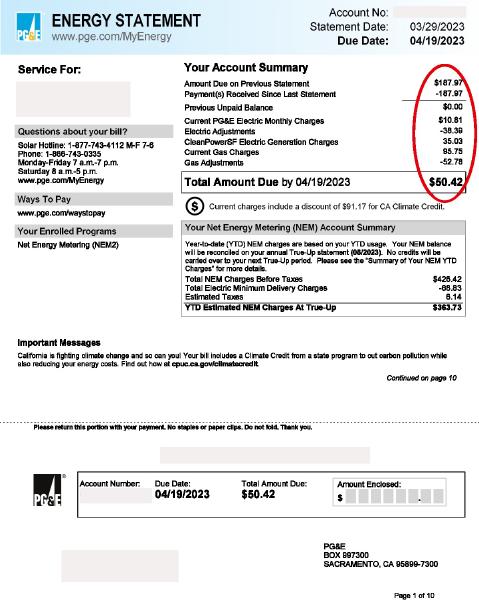
PG&E Bill 2023-03, Page 1
Ignoring the gas charge and Gas Adjustments, the PG&E Monthly charge is about the same as in winter. This is a little odd because, if you peek ahead, you’ll see that we used $65.54 of PG&E energy this billing cycle. That’s NEM—we won’t pay for that until the annual True-Up.
We also have an Electricity Adjustment—that’s the Climate credit, detailed on page 7.
And we have the CleanPowerSF Generation Charge. This was 0 in the summer; but now it’s $35.03. That’s broken out on page 8.
Pages 2, 3, and 4 are roughly the same in the summer and the winter, so we’ll skip them today.
Page 5: PG&E Monthly Charges
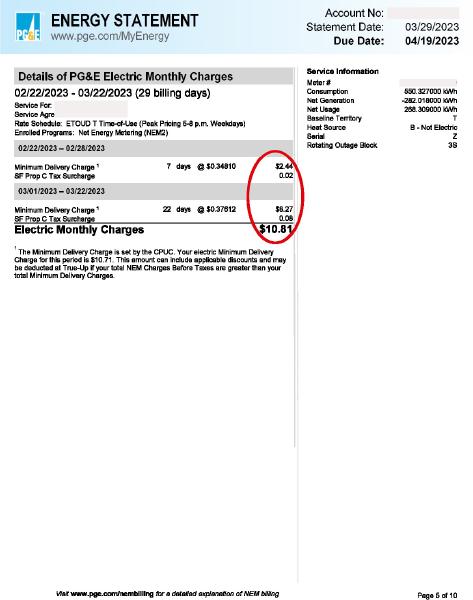
PG&E Bill 2023-03, Page 5
Note that PG&E slips the Prop C charge, which again is a payroll tax on big businesses in SF and not a utility rate thing, into the monthly minimum.
Page 6: Details of PG&E Monthly Charges

PG&E Bill 2023-03, Page 6
Page six breaks out the full charge. It’s a little complicated because, surprise4, the rate increased in the middle of the billing period. The breakout rows are the same as the summer bill we looked at previously, except that most of the signs are reversed. Per-kW·h charges, Power Charge Indifference Adjustment, Franchise Fee Surcharge, and SF Prop C Tax Surcharge are negative in the summer and positive in the winter. The NBC Net Usage Adjustment and Generation Credit, which were positive in the summer, are negative in the winter. The only thing that doesn’t change is the State Mandated Non-Bypassable Charge, which is always positive.
Page 7: Adjustments
March and October bills include the Climate Credit for electricity5. The Credit shows up in the Account Summary on Page one (see above), and also gets an page of its own:
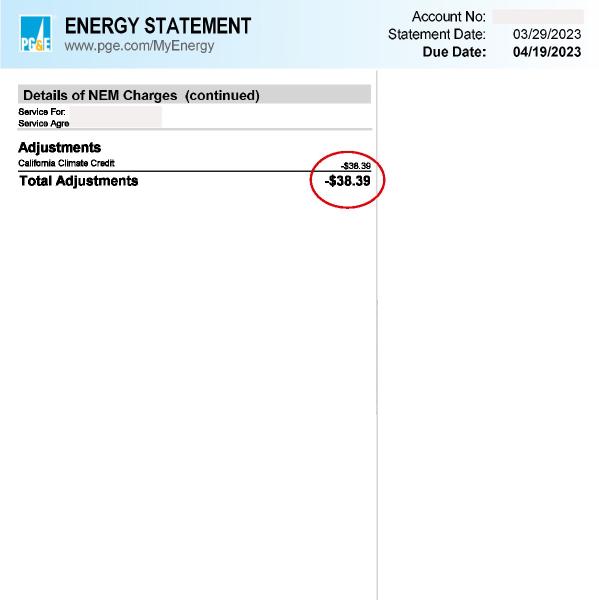
PG&E Bill 2023-03, Page 7
CPUC tells us6 that
The climate credit provides ratepayers with their share of the benefits of California’s Cap-and-Trade Program. Usually, these credits are distributed twice a year, in April and October. Most residents receive a natural gas credit in April, and electric credits in April and October.
Page 8: CleanPowerSF

PG&E Bill 2023-03, Page 8
You will recall that we are only paying PG&E for transmission—and thanks to NEM, we pay a minimum amount each month until the True-Up, whether we had a surplus or deficit. Meanwhile, we pay CleanPowerSF for acquiring the energy, and CleanPowerSF’s True-Up only runs in one direction. If you owe money, you pay that month, and if you have a surplus, you pay nothing. In the winter, we owe, so we pay up.
The confusing part here is the CleanPowerSF NEM Balance Owed, which is $0, and the CleanPowerSF NEM Energy Balance, which is 1869.114 kW·h. How can one balance be zero while the other is multiple months worth of energy? That’s at least in part because we pay CleanPowerSF every month if we were net deficit, so the balance never drops below zero. The Balance is the net amount of energy we’ve gotten from CleanPowerSF since starting NEM—the label is unhelpfully ambiguous unless you know exactly what plus and minus are supposed to mean in this context, but since this is a late winter bill, it can’t be a surplus. I wondered why this number wasn’t zero, given that we paid for all of that energy already. I have a guess; let’s come back to this later.
A PG&E True-up Bill
In the August 2023 bill, a year after we started NEM2, we true up with PG&E.
Page 1: Account Summary
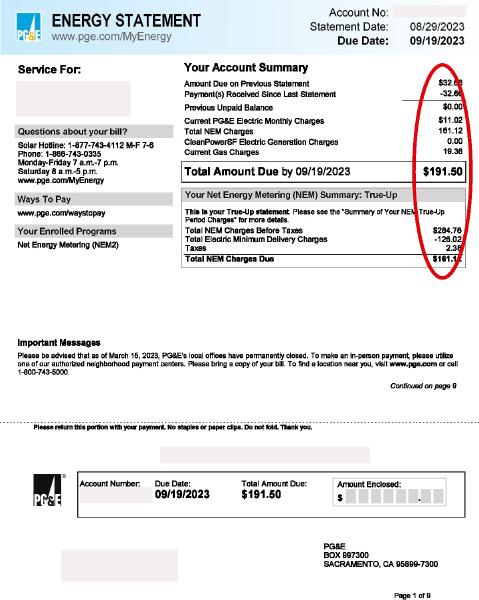
PG&E Bill 2023-08, Page 1
On the summary page, we can see that we still pay the monthly minimum. We also pay $191.50 as the bill come due for all the energy we took from PG&E without giving back. This billing period was a summer period, so we don’t owe CleanPowerSF, nor do we get anything back from them.
Page 3: Summary of PG&E NEM True-Up
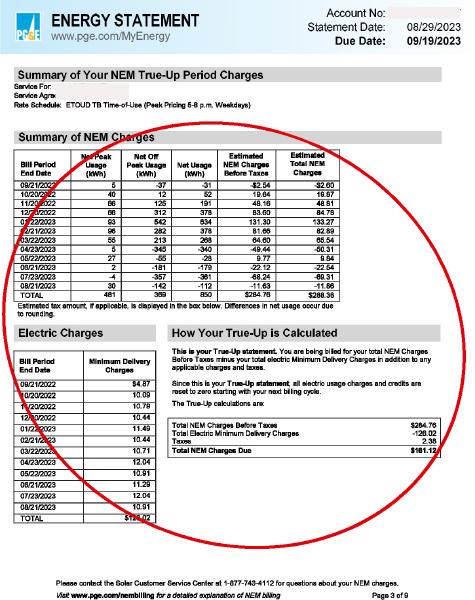
PG&E Bill 2023-08, Page 3
This is the same page 3 as in every bill, but it’s True-Up so we can finalize the numbers. We owe $284.76 for using, according to this, a net 850 kW·h from PG&E. But all those monthly minimum payments count against this, and then some tax comes back in, and the final number is $181.12, the same as on page 1.
Page 5: Details of PG&E Monthly Charges

PG&E Bill 2023-08, Page 5
Since it’s True-Up, this page has the same numbers as Page 3. The 12-month cycle foretold in the prophecy is finally complete, and all of our NEM accounts are squared away. Of course, we want to count how much money we saved in 20237, not from August 2022 to August 2023, so we’ll have to do a little bit more tallying. Let’s save that for next week, when we break out the spreadsheet